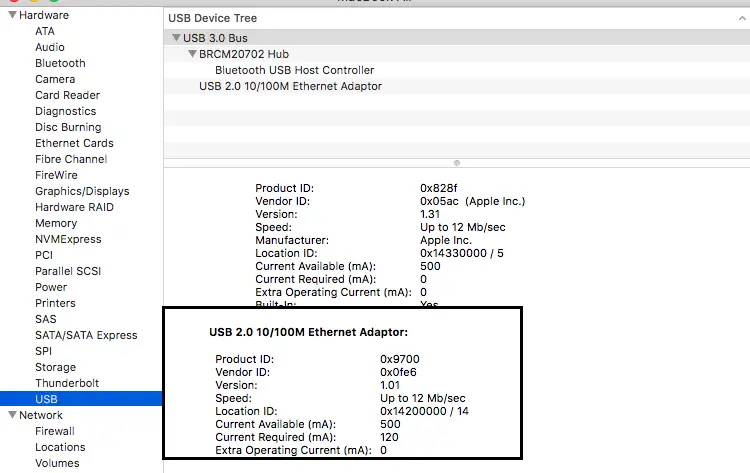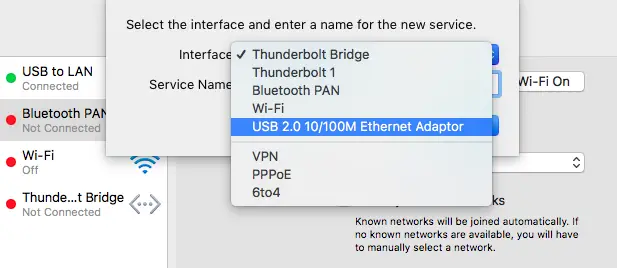Update: This trick also works with macOS High Sierra.
If you bought a cheap USB 2.0 to Ethernet adapter for your MacBook Air or MacBook Pro 13 inch 2015, then you know the simple plug and play does not work. Surely all the 3rd party adapters available on eBay are guaranteed to be functional.
Before starting banging your head check if the device is detected by your laptop. Go to About this Mac then check the USB tab in system report.

If you see something like the above picture we are ready to go, otherwise get the cable replaced or get a new one. In my case, I had to purchase three adapters to get one functional.
After reading lots of how-to tutorials regarding this issue with Mac OS El Captain and Yosemite I came to know the problem has something to do with SIP (System Integrity Protection). So without wasting time, I disabled it and restarted the machine. With full excitement, I went to network preferences and clicked the + button, but there was no USB Ethernet interface listed. If you want to give it a try, follow the steps mentioned below.
How to Disable System Integrity Protection in Mac OS:
- Restart your laptop and wait till the keyboard and display become completely black. Press and hold down the command(⌘) + R button to start recovery mode.
- Open terminal from the “Utilities” option.
- Type csrutil disable and restart the device.
- Now open Network from System Preferences and click on + button.
- If you see a new networking interface like USB 2.0 to 10/100M Ethernet select and start using the internet.
For those, the fix as mentioned above does not work, use the following method.
Enable Ethernet Adaptor on macOS 10.12 Sierra:
- First, disable the SIP if not done already. As most of the generic adapter comes with ASIX chip, you can download the Mac OS drivers from their website.
- Download and install the driver file.
- Now add it to the kernel extension list by running sudo kextload /Library/Extensions/AX88178.kext .
- Restart the device and check-in Network Preferences, you will probably see the new interface.

Still not working?
Gently open the box where the ethernet cable is plugged in and check the id above the chip. Search and download proper drivers from the manufacturer and enable it. There another collection of generic drivers available for this kind of device in this link.
hello sir,
Your articles are very good for us in this you talk about pros and cones of USB device which is very benefitless for all the I.T workers because nowadays there are lots of unethical work by the USB device your article gives us awareness about USB.
Thanks for sharing.
Hi Dear,
Your article is very attractive and helpful keep it up.
Thanks to share us.
very informative post
In my Mac, it is saying sudo command is not found. What should I do? I have Mac book air 2017(Sierra 10.12.6)os
Very strange situation because every Linux/Unix environment has a sudo mode unless you messed up the .bashrc file.
Please try `sudo su` and paste the output in the comment section.
It is again saying that sudo command is not found.
Read the following thread from StackExchange for a quick fix.
https://apple.stackexchange.com/questions/282299/sudo-command-not-found/282485
Hello ,
Nice topic , after reading your article i get more knowledge and i am sure this is one of the best article you write. Keep it up.
Thank you solve my problem using Open terminal from “Utilities” option.
Type csrutil disable and restart the device.
Best
Great post, thanks a lot.
I had to walk through the last step and downloaded the driver for my MacBook Pro (late 2012) with High Sierra for AX88772B (in Goobay product USB 2.0 fast ethernet network converter, b.t.w. it says in system overview it is/has USB 3.0 bus) at http://www.asix.com.tw/download.php?PItemID=105&sub=driverdetail
And it works!!! 🙂
Thanks for sharing the info. 😀
Great, it worked!
Be sure to check the driver you need instead of blindly installing AX88178 first like I did.
– MacBook Pro, High Sierra 10.13.3
– Goobay USB 2.0 10/100MB Ethernet Adapter
Like shown in the tutorial, if you connect an adapter with an ASIX chip inside it should show up under About this Mac -> Hardware -> USB. In my case I had to install AX88772B, also available from the ASIX website. Adding it to the kernel extension list was done automatically by the ASIX installer.
Thanks for the tip.
Another common chip type in cheap USB Ethernet adapters is RealTek RTL815x. I had a spesific use case: the Ethernet port was dead in my old Mac (OS X 10.6 Snow Leopard), and I needed more USB ports. On the Mac, some information about the chips may be found with System Profiler, item USB. My adapter is LENTION 3 USB Port Hub + RJ45 Lan Adapter (USB 2.0 and Ethernet 10/100). The driver RealTek provides now (2019) is RTUNICv1.0.17. It does not work with Snow Leopard and/or chips in the adapter. An older version of RealTek driver is found http://www.szyuanxin.cn/wkqd and it works with Snow Leopard and the chips in the adapter, namely RTUNICv1.0.10 and v1.0.11
Thanks, Tuomas for sharing the info.
For mac users on >10.9 and an ASIX chip adapter: I was fine just installing via the dmg from https://www.asix.com.tw/download.php?PItemID=105&sub=driverdetail. I’d suggest trying this first instead of disabling SIP. During the installation it should automatically ask you to mark the driver as a trusted program.
Thanks, for the info. I was not able to make it work on MacOS 10.14.
same here. Has anyone got a way to do that as at now?
Is there a new method for enabling the fast adapter on Mac? I have tried all the solutions that was posted here but it’s not working, I’m on 10.14.5 Mojave.
THANK YOU !!! Life saver
thak you very much, it really helped me!
The last line saved me!
Thank you so much!
It doesn’t work in Catalina. Could you help me?
I’ve not tested the drivers on macOS Mojave or Catalina, I’ll update the tutorial soon.
Hello, did you find a way to make it work in macOS Catalina?
thanks
We are testing some new drivers on macOS Catalina.
Waiting for an update on Catalina. Thank you in advance
Also waiting on the update. Thank you
Thanks for your suggestions. The Ethernet worked after dis enabling SIP / installing the driver. To protect the machine from malware, I re-enabled SIP but post that the Ethernet doesn’t work again ! any thoughts
Hi. Do you use Catalina and does it work on it?
This is still working in BigSur 11.4 you need to keep SIP disabled.
Thanks for the help!
Hi Carlos, Thanks for sharing the update.
searching the drivers for chipset worked for me. Thanks a lot.